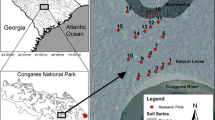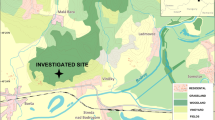Abstract
We used tree-ring dating and 14C dating to document the temporal distribution and carbon storage of oak (Quercus spp.) wood in trees recruited and buried by streams and floodplains in northern Missouri, USA. Frequency distributions indicated that oak wood has been accumulating in Midwest streams continually since at least the late Pleistocene, about 14,000 calibrated radiocarbon years before present (cal. BP). The median residence time of an oak bole in the study streams was 3,515 years (n = 200). More than 30% of sampled oak wood entered the floodplain sediments and stream waters within the last 1,000 years, though very few samples dated to the last 150 years. Temporal variability in the record of oak recruitment to streams suggests a potentially strong influence from shifts in climate and fluvial processes, although other possible influences are addressed. Recent human impacts on streams have altered the dynamics of oak input and sequestered carbon with unknown long-term consequences. The long duration of carbon storage (mean age = 1,960 years) in this waterlogged environment appears to be strongly limited by decreasing wood density resulting from reductions in cell wall thickness. Lack of evidence of biotic degradation may imply that wood loss is largely due to abiotic hydrolyses. These findings document a continuous and long-term form of carbon storage that is sensitive to changes in climate and anthropogenic alteration of fluvial processes.





Similar content being viewed by others
References
Abbe TB, Montgomery DR 2003. Patterns and processes of wood accumulation in the Queets River Basin, Washington. Geomorphology 51:81–107.
Abrams MD 2002. The postglacial history of oak forests in eastern North America. In: McShea W, Healy W, Eds. Oak forest ecosystems: ecology and management for wildlife. Baltimore: Johns Hopkins University Press. pp 34–45.
Arbogast AF, Johnson WC 1998. Late Quaternary landscape response to environmental change in south-central Kansas. Ann Assoc Am Geogr 88:126–45.
Baillie MGL 1982. Tree-ring dating and archaeology. Chicago, IL: University of Chicago Press. 274 p.
Baker RG, Chumbley CA, Witinok PM, Kim HK 1990. Holocene vegetational changes in eastern Iowa. J Iowa Acad Sci 97: 67–177.
Barnes BV, Zak DR, Denton SR, Spurr SH 1998. Forest ecology. New York: John Wiley.
Becker B 1993. An 11,000-year German oak and pine chronology for radiocarbon calibration. Radiocarbon 3:201–13.
Benda L, Miller D, Sias J, Martin D, Bilby R, Veldhuisen C, Dunne T 2003. Wood recruitment processes and wood budgeting. In: Gregory S, Boyer K, Gurnell A, Eds. Ecology and management of wood in world rivers. Bethesda, MD: American Fisheries Society. pp 49–73.
Benke AC, Wallace JB 2003. Influence of wood on invertebrate communities in streams and rivers. In: Gregory S, Boyer K, Gurnell A, Eds. Ecology and management of wood in world rivers. Bethesda, MD: American Fisheries Society. pp 149–77.
Bilby RE 2003. Decomposition and nutrient dynamics of wood in streams and rivers. In: Gregory S, Boyer K, Gurnell A, Eds. Ecology and management of wood in world rivers. Bethesda, MD: American Fisheries Society. pp 135–47.
Birdsey RA. 1996. Carbon storage for major forest types and regions in the conterminous United States. In: Sampson RN, Hair D, Eds. Forests and global change, volume 2: forest management opportunities for mitigating carbon emissions. Washington, DC: American Forests. pp 1–26, 261–372
Blanchette RA, Nilsson T, Daniel G, Abad A. 1990. Biological degradation of wood. In: Rowel R, Barbour R, Eds. Archaeological wood. Advances in Chemistry Series 225. Washington, DC: American Chemical Society. pp 141–76
Brown AG 1997. Alluvial geoarchaeology: floodplain archaeology and environmental change. Cambridge, MA: Cambridge University Press. p 377.
Daniels JM, Knox JC 2005. Alluvial stratigraphic evidence for channel incision during the Mediaeval Warm Period on the central Great Plains, USA. Holocene 15:736–47.
Dinwoodie JM 1981. Timber, its nature and behaviour. New York: Van Nostrand Reinhold. p 190.
Dixon RK, Brown S, Houghton RA, Solomon AM, Trexler MC, Wisniewski J 1994. Carbon pools and flux of global forest ecosystems. Science 263:185–90
Duvick DN. 1996. Lake Ahquabi State Park. International Tree-Ring Data Bank. IGBP PAGES/World Data Center-A for Paleoclimatology Data Contribution: IA025.CRN2–014. NOAA/NGDC Paleoclimatology Program. Boulder CO, USA
Eaton RA, Hale MDC 1993. Wood decay, pests and protection. London: Chapman and Hall.
Gregory SV, Boyer KL, Gurnell AM, Eds 2003. Ecology and management of wood in world rivers. Bethesda, MD: American Fisheries Society.
Grissino-Mayer HD, Holmes RL, Fritts HC. 1996. International Tree-Ring Data Bank Program Library Version 2.0 Users Manual. Laboratory of tree-ring research, University of Arizona. International Tree-Ring Data Bank
Grüger J 1973. Studies on the late quaternary vegetation history of northeastern Kansas. Geol Soc Am Bull 84:239–50.
Guyette RP, Cole WG 1999. Age characteristics of coarse woody debris (Pinus strobus) in a lake littoral zone. Can J Fish Aquat Sci 56:496–505.
Guyette RP, Cole WG, Dey DC, Muzika RM 2002. Perspectives on the age and distribution of large wood in riparian carbon pools. Can J Fish Aquat Sci 59:578–85.
Guyette RP, Stambaugh MC 2003. The age and density of ancient and modern oak wood in streams and sediments. Int Assoc Wood Anat J 24:345–53.
Harmon ME, Franklin JF, Swanson FJ, Sollins P, Gregory SV, Lattin JD, Anderson NH, Cline SP, Aumen NG, Sedell JR, Lienkaemper GW, Cromack K Jr, Cummins KW 1986. Ecology of coarse woody debris in temperate ecosystems. Adv Ecol Res 15:133–302.
Hyatt TL, Naiman RJ 2001. The residence time of large woody debris in the Queets River, Washington, USA. Ecol Appl 11:191–202.
IPCC 2001. Climate change 2001: the scientific basis. Intergovernmental Panel on Climate Change (IPCC). [online] http://www.grida.no/climate/ipcc_tar/wg1/index.htm
Knox JC 1983. Responses of river systems to Holocene climates. In: Wright HE Jr, Ed. Late quaternary environments of the United States, the Holocene, volume 2. Minneapolis: University of Minnesota Press. pp 26–41.
Knox JC 2003. North American paleofloods and future floods: responses to climatic change. In: Gregory KJ, Benito G, Eds. Paleohydrology: understanding global change. Chichester: Wiley. pp 143–64.
Laird KR, Fritz SC, Grimm EC, Mueller PG 1996. Century-scale paleoclimatic reconstruction from Moon Lake, a closed-basin lake in the northern Great Plains. Limnol Oceanogr 41:890–902.
Leopold LB, Wolman MG, Miller JP 1964. Fluvial processes in geomorphology. San Francisco: W.H. Freeman and Co.
MacMillian PC 1988. Decomposition of coarse woody debris in an old-growth Indiana forest. Can J For Res 18:1353–62.
Montgomery DR, Abbe T 2006. Influence of logjam-formed hard points on the formation of valley-bottom landforms in an old-growth forest valley, Queets River, Washington, USA. Quatern Res 65:147–55.
Nabuurs GJ, Mohren GMJ 1995. Modeling analysis of potential carbon sequestration in selected forest types. Can J For Res 25:1157–72.
Nigh TA, Schroeder WA 2002. Atlas of Missouri ecoregions. Jefferson City, MO: Missouri Department of Conservation.
O’Conner NA 1991. The effects of habitat complexity on the macroinvertebrates colonizing wood substrates in a lowland. Oecologia 85:504–12.
Panshin AJ, DeZeeuw C 1970. Textbook of wood technology. New York: McGraw-Hill. p 736.
Panyushkina IP, Leavitt SW, Wiedenhoeft A, Noggle S, Curry B, Grimm EC 2004. Tree-ring records of near-Younger Dryas time in central North America—preliminary results from the Lincoln Quarry site, central Illinois, USA. Radiocarbon 46:933–41.
Piegay H, Gurnell AM 1997. Large woody debris and river geomorphological pattern: examples from S.E. France and S. England. Geomorphology 19:99–116.
Pilcher JR, Baillie MGL, Schmidt B 1984. A 7272 year tree-ring chronology for Western Europe. Nature 312:150–52.
Richardson BA 1978. Wood preservation. London: The Construction Press. p 238.
Sampson NR, Hair D Eds 1996. Forests and global change, volume 1. Washington, DC: American Forests.
SAS, version 9.1, 2003. SAS Institute, Cary, NC
Sentilles D 1989. Applying calculus in the economic and life sciences. Belmont, CA: Wadsworth Publishing. p 703.
Spetich MA, Shifley SR, Parker GR 1999. Regional distribution and dynamics of coarse woody debris in Midwestern old-growth forests. For Sci 45:302–13.
Stokes MA, Smiley TL 1996. An introduction to tree-ring dating. Tucson: University of Arizona Press.
Stuiver M, Reimer PJ 1993. Extended 14C data base and revised CALIB 3.0 14C age calibration program. Radiocarbon 35:215–30.
Stuiver M, Reimer PJ, Braziunas TF 1998. High-precision radiocarbon age calibration for terrestrial and marine samples. Radiocarbon 40:1127–51.
Vandike JE. 1995. Missouri state water plan series, volume 1. Surface water resources of Missouri. Missouri Department of Natural Resources, Division of Geology and Land Survey, Water Resources Report Number 45. 122 p
Van Zant KL 1979. Late glacial and postglacial pollen and plant macrofossils from Lake West Okoboji, northwestern Iowa. Quatern Res 12:358–80.
Williams JW, Shuman BN, Webb T III, Bartlein PJ, Leduc PL 2004. Late Quaternary vegetation dynamics in North America: scaling from taxa to biomes. Ecol Monogr 74:309–34.
Wondzell SM, Bisson PA 2003. Influence of wood on aquatic and riparian biodiversity. In: Gregory S, Boyer K, Gurnell A, Eds. Ecology and management of wood in world rivers. Bethesda, MD: American Fisheries Society. pp 249–263.
Wright HE Jr. 1968. History of the prairie peninsula. In: Bergstrom R, Ed. The quaternary of Illinois. Special Report Number 14. Urbana, IL: College of Agriculture, University of Illinois. pp 77–88
Acknowledgments
The authors want to thank the University of Missouri’s Center for Agroforestry, the Northern Research Station of the U.S. Forest Service, Melvin Stotts, Steve Peterson, Tom Faust, and Joe Marschall for their support and efforts in this research. This research is supported by the National Science Foundation Grant # ATM-0601884. This manuscript was greatly improved by the editorial skills of Erin McMurry and comments from three reviewers.
Author information
Authors and Affiliations
Corresponding author
Rights and permissions
About this article
Cite this article
Guyette, R.P., Dey, D.C. & Stambaugh, M.C. The Temporal Distribution and Carbon Storage of Large Oak Wood in Streams and Floodplain Deposits. Ecosystems 11, 643–653 (2008). https://doi.org/10.1007/s10021-008-9149-9
Received:
Revised:
Accepted:
Published:
Issue Date:
DOI: https://doi.org/10.1007/s10021-008-9149-9




